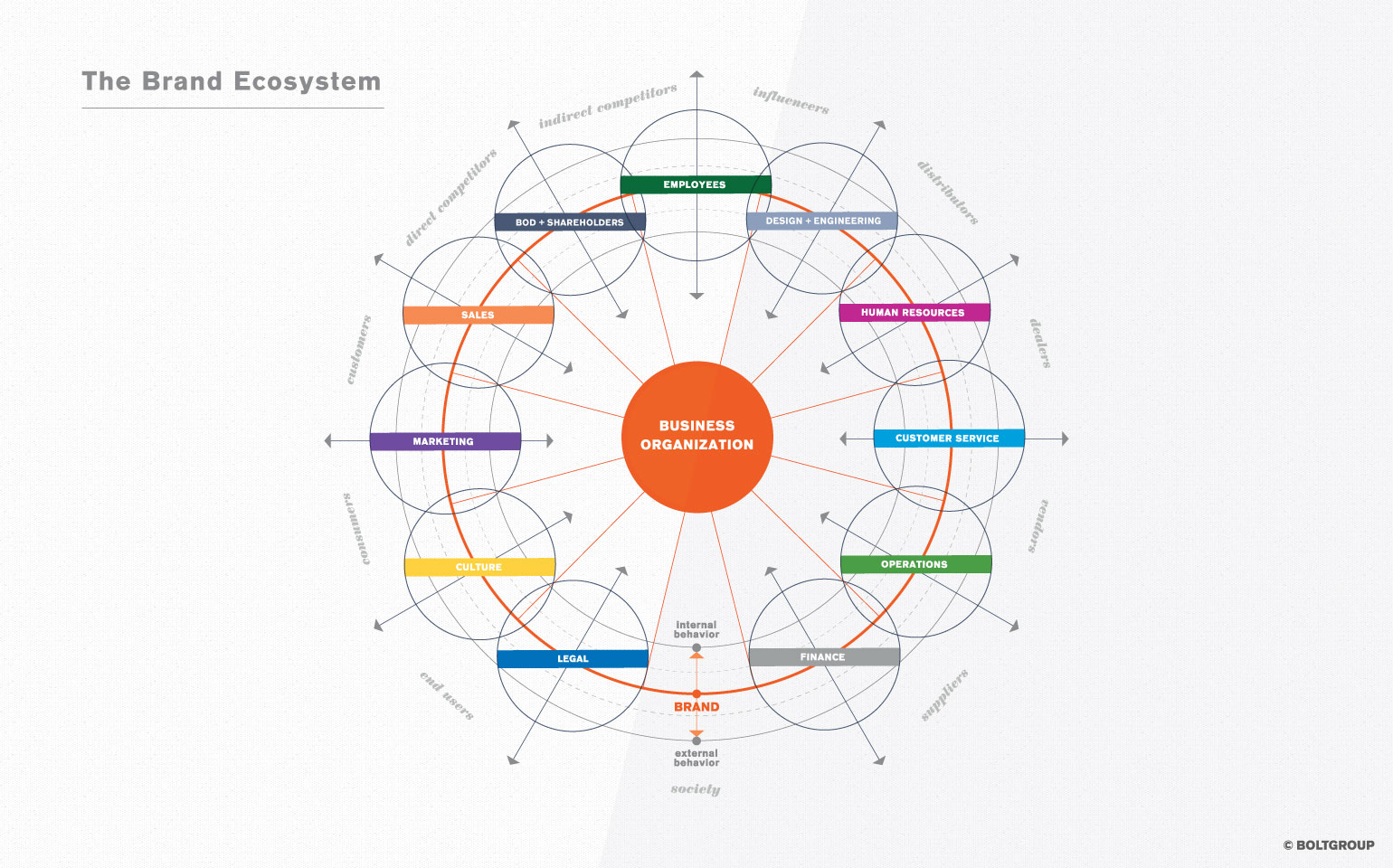con•nec•tive tis•sue—A group of tissues within the body that maintain the form of the body and its organs and provide cohesion and internal support. Think bones, ligaments, tendons, cartilage, even fat tissue. Your brand has these same types of tissue (purpose, pillars, positioning, visual and verbal identity, and voice). When deployed properly, these “tissues” can maintain the form of the body (your organization) and its organs (your people), and provide cohesion and support. But a brand’s connective tissue can do even more.
The connective tissues of your brand are like strands of continuity:
They can be the tangible elements. Like consistent application of visual and verbal brand identity assets, and tone and manner of how your brand position is communicated to your various audiences.
They can be the intangible elements—your team and their daily actions—as a reflection of brand fidelity and position.
They can be about the idea–the truth of purpose that holds you all together.
They can be about culture–the way you’ve created an environment for all of this to naturally manifest around and through the brand.
In truth, for successful organizations, brand IS the connective tissue of an organization. The key is finding and understanding yours, and then using it to better align your business goals with your brand strategy, resulting in positive behavioral change toward your brand–both internally and externally. Let ‘s examine a few places to look for connective tissue.
1. The Brand Foundation
Start at the beginning. Why does your brand exist? And what does it stand for? And how is that expressed? Your brand foundation is where you find these answers. And more. It informs your brand, and your organization, based on the insights that are gathered to determine who your audiences are, and what position your brand should hold in their minds. Also how the value proposition of each audience may be different, but at the end of the day all ladder back up to communicating the compelling truths of your brand. Your brand foundation is the connective tissue between your business goals and your brand strategy. It is the deepest and most meaningful explanation of why you are in business. Or it should be.
Often we are called upon to help fix a problem with an organization’s brand. It may be a web problem. It may be a packaging problem. It may be a collateral problem. It may be an identity problem…You get the idea. But what we discover if allowed to look deep enough, is that we’re being asked to fix the symptom, not the source. The cause almost always lies deeper in the body. The hardwiring has gone awry. Or hardwiring was never there. The connective tissue is missing. Very often, going back to examine the brand foundation uncovers the real problem. When corrected, it allows the brand to flow through the organization like lifeblood through veins. Examine your brand foundation for the 5 P’s of brand (purpose, pillars, position, personality, proposition) and if these aren’t current, relevant, and being communicated clearly and simply, it’s the place to start building your connective tissue.
2. The Brand Identity
So often, when auditing an organization’s existing brand, we find a number of disjointed visual identity assets—multiple versions of business cards, old logos, type treatments, sub-brands, patterns, colors, print grids, even bad photography and illustrations or graphs. When seen by themselves, in a vacuum, these elements might not look so terrible. But when viewed together, such as for a major tradeshow or product launch event, you see just how far your brand identity has slipped into a sea of visual mishegoss, and lost all sense of connective tissue.
While the brand foundation may be the soul of your brand, the visual brand identity represents the physique–the outward appearance. And every time someone joins the organization and gets their business cards printed at the corner quick-print, or produces their own sales deck for a major presentation or line review, your brand is diluted, weakened, and fragmented–The physique gets a little flabby. On the other hand, when a brand identity system is closely managed and protected, and regularly audited against the brand foundation and strategy, you see a consistent, cohesive identity that expresses the truth, transparency, and authenticity originally planned for the brand. Peak fitness. Let your brand identity work for you, by supporting it and holding it in high regard as one of your greatest assets.
3. The Brand Experience
We have often written on this subject. A brand is a living, breathing thing. It can impress and delight your customers and consumers at every turn, both internally and externally. This creates brand experiences–emotive moments in the customer journey that have meaning, create value, and drive preference for your brand. Think of that first handshake with someone you’ve never met. What impression are you left with? Or a first date? Or the first time you held your child? The body and the mind can connect sensory information to an event, giving you crystal recall of everything about the experience years later. The touch. The look. The sound. The smell. Everything is captured and stored together as a collective memory for that one experience. The greater the experience, the stronger the connective tissue that keeps the memory intact.
The same opportunity exists for your brand. Consider the connective tissue that exists between your brand pillars and purpose, and how your HR department interacts with potential candidates. The contact can and will create a brand experience that is lasting for that candidate, either drawing them closer to your organization, or driving them away where they’ll share their experience with friends. Use your brand foundation as your filter and the brand identity as your style guide. Brand experiences can be large or small, grand or intimate, and evoke the very same feelings. But they must be intentionally designed to trigger those feelings. The touch, the look, the sound, and the smell you experience with your tradeshow exhibit becomes the connective tissue that has meaning, creates value, and drives preference for your brand.
4. The Brand Communication
How many of you have been watching TV, reading a magazine, or surfing the web and seen a product ad that afterwards, a] you couldn’t remember the brand, and/or b] the ad didn’t make any sense for the intended audience? Not to pick on ad agencies, but WTH? Yes, brand communications are supposed to be arresting and memorable, but they are also supposed to inform the viewer about the brand and the products or services they represent. Or take the viewer on a meaningful journey with the brand. They are supposed to have an intelligent conversation with you. And why are so many ads fun or silly for a brand that is patently serious? I know that sounds like a joke set-up. Well here’s the punch line—they are examples of bad brand communications.
Once again, the connective tissue between the brand heart and soul and the brand body and brain is missing. We don’t claim to be an ad agency. We are a design firm. And inasmuch, we design things. We brand things. However, we’re often called on to communicate the meaning and value of those things in the marketplace, because we know more about the meaning and value of those things than anyone else. We have a wonderful healthcare client we’ve served off and on for the past nine years. While helping to create the connective tissue that is the brand for FOX Rehabilitation, we were immersed into the culture of the brand, and what being a clinician meant at FOX. It was only natural that we worked to design ways to recruit more clinicians and referrals, based on that connective tissue. Showing the passion, the care, the desire to help people be their best at any age, informed how we communicated for FOX. Following our recruitment campaigns and brand communications, more than 500 new clinicians joined FOX in 2017.
5. The Brand Culture
This is a biggie. It’s fair to say that you may not have a brand at all if you do not have a brand culture. Truth, transparency, authenticity, simplicity, and clarity of brand all emanate from within the organization. No amount of spiff or spin can conjure that up. Creating a brand culture is often easy for the founder. In the early years, the purpose of the brand is self-evident and fidelity of brand is upheld and protected. The connective tissue is part of its very being. It’s when success and growth start to overtake the founding priorities of legacy and purpose, that a culture of brand can be eclipsed by a culture of operations, or sales, or [insert your poison]. Time, growth, and success can have very positive effects on an organization. But without a vigilant brand steward and insistence of maintaining a high degree of culture around and for the brand, it can erode, fragment, and deteriorate right before your eyes.
There are very profound examples of brand culture in today’s marketplace–from the ubiquitous tale of Apple [one I’ve told many, many times] to Virgin, to John Deere, to Warby Parker, to FOX Rehabilitation. With every example listed, there is a brand champion, often (but not always) the founder, who makes it their job (sometimes their primary job) to constantly, consistently, and cohesively communicate and project the connective tissue of the brand upon its many, many constituents. Ed just penned a recent article on the subject.
If your organization is some years from its beginning, dig up the archives and minutes of early board meetings and see what was driving the business and the brand. What was the purpose? And how is it different [or not] now? Then audit your brand. Everything we’ve touched on so far needs to be assessed to see how it might be reflecting the purpose. Next, audit your people. Ask them what they think the brand means. How they feel about the brand. While you’re at it, do the same with your customers and end users. Periodic baseline equity research can inform your organization as to where the brand is leaning and give you a chance to make adjustments that better reflect the alignment between your business goals and your brand strategy. It is this purposeful alignment that sets the trajectory you want your brand to have. This strong alignment will greatly influence a positive behavioral change toward your brand, both internally and externally.
6. The Brand Ecosystem
If the previous five areas on this list can be found throughout your brand connective tissue, then the connective tissue itself lives and moves through here–the brand ecosystem. Within the brand ecosystem is the design that connects your foundation to your identity, which is then reflected through the experiences created, and communicated both inwardly and outwardly, forming and informing the culture within your brand. Constantly feeding and nurturing the brand, this ecosystem serves as the circulatory system of your brand’s body, delivering the elements necessary to thrive, grow, and sustain itself.

